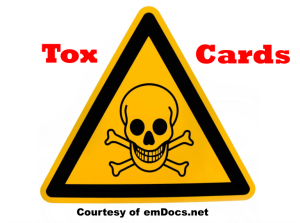Author: Kristin E. Fontes, MD (Emergency Physician, Santa Barbara Cottage Hospital and Goleta Valley Cottage Hospital) // Edited by: Cynthia Santos, MD (Senior Medical Toxicology Fellow, Emory University School of Medicine), Alex Koyfman, MD (@EMHighAK, EM Attending Physician, UTSW / Parkland Memorial Hospital), and Brit Long, MD (@long_brit, EM Attending Physician, San Antonio Military Medical Center)

Case presentation:
A 25-year-old male is brought to the emergency department by ambulance after he was seen running naked into traffic. He is extremely agitated and screaming nonsensically. Vital signs are as follows: T 39.0C, HR 125, BP 156/90, RR 24, SpO2 98% on room air.
Questions:
What are synthetic cathinones? What are the potentially life-threatening complications of toxicity?
Pearls:
- Cathinone, a monoamine alkaloid, is naturally occurring in the Khat plant (Catha edulis); synthetic derivatives were first identified in the 1920s – investigated for treatment of depression, obesity, and chronic fatigue
- Similar in structure to amphetamines, both are phenylethylamines

- Common illicit synthetic cathinones (“bath salts”) include mephedrone, methylone, and MDPV
- Frequently used orally or insufflated, less commonly smoked or injected
- Mephedrone and methylone mimic MDMA (“ecstasy”) effects
- MDPV mimics cocaine effects (but much more potent)
- Marketed as “bath salts”, “plant food,” and “research chemicals”
- Complications:
- Rhabdomyolysis: study of patients with single-stimulant exposure and sympathomimetic toxidrome features. (1)

-
- Odds ratio for severe rhabdomyolysis for synthetic cathinone vs non-cathinone: 7.98
- Cause of rhabdomyolysis: may be due to skeletal muscle overuse due to seizures or hyperactivity, vasoconstriction causing muscle ischemia, hyperthermia, or impaired ATP production due to impaired cellular respiration
-
- Rhabdomyolysis: study of patients with single-stimulant exposure and sympathomimetic toxidrome features. (1)
- Seizures: analysis of pediatric patients with known synthetic cathinone exposures within the American Association of Poison Control Centers database. (2)
- Seizures occurred in 5.5% of patients
- 50.7% had single seizures; 39.7% had multiple seizures, 9.6% had status epilepticus
- Fever and acidosis were associated with all seizure types
- Bupropion:
- Cathinone used as an antidepressant and as smoking cessation treatment
- Inhibits dopamine and norepinephrine reuptake; no effect on serotonin reuptake or monoamine oxidase (MAO)

-
- Abusers grind pills for injection or insufflation
- In a review of bupropion insufflation cases reported to the California Poison Control System, 30% had seizure – 95% of these patients presented with tachycardia. (3)
- No delayed seizures reported (contrast to association with oral bupropion)
Main points:
- Synthetic cathinones are similar to amphetamines in structure and clinical presentation
- Potentially life-threatening complications of synthetic cathinones include rhabdomyolysis and seizures
- Bupropion is a cathinone derivative that carries abuse potential
References/Further Reading:
- O’Connor AD, Padilla-Jones A, Gerkin RD, Levine M. Prevalence of rhabdomyolysis in sympathomimetic toxicity: a comparison of stimulants. J Med Toxicol 2015 Jun;11(2):195-200.
- Tekulve K, Alexander A, Tormoehlen L. Seizures associated with synthetic cathinone exposures in the pediatric population. Pediatr Neurol 2014 Jul;51(1):67-70.
- Lewis JC, Sutter ME, Albertson TE, Owen KP, Ford JB. An 11-year review of bupropion insufflation exposures in adults reported to the California Poison Control System. Clin Toxicol (Phila) 2014 Nov;52(9):969-72.








